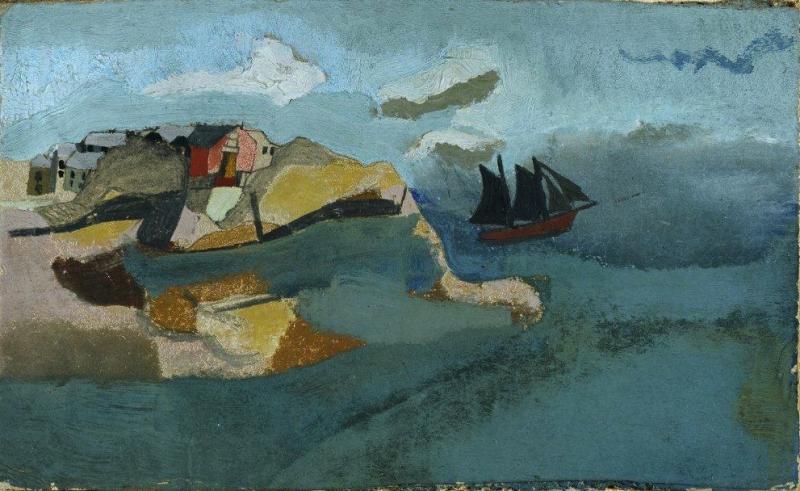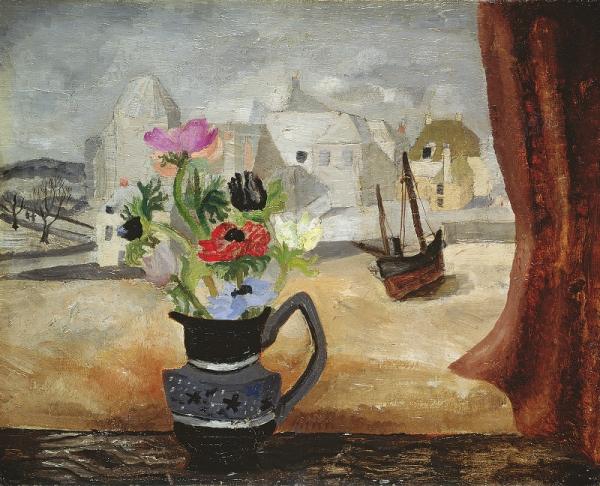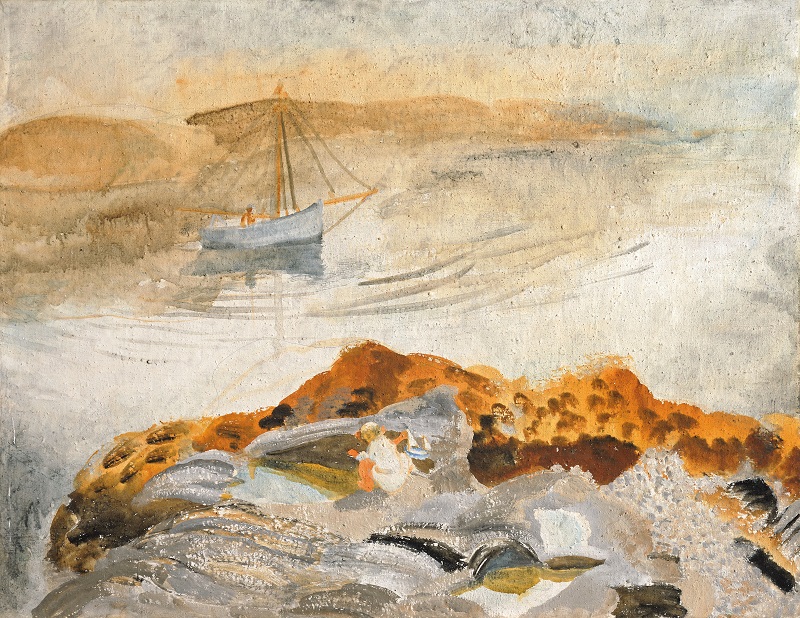Art and Life: Ben and Winifred Nicholson, Dulwich Picture Gallery | reviews, news & interviews
Art and Life: Ben and Winifred Nicholson, Dulwich Picture Gallery
Art and Life: Ben and Winifred Nicholson, Dulwich Picture Gallery
Intense personal relationships fuelled the creativity at the heart of British modernism

At the risk of sounding crass, I can’t help feeling that had Winifred Nicholson painted fewer flowers she might be better represented in the annals of art history. Of course, being a woman hasn’t helped, but as a woman flower painter she was ever destined for the footnotes.
Next to the white reliefs and austere abstract paintings that have secured her husband's reputation in the vanguard of British modernism, Winifred’s paintings are, superficially at least, steadfastly domestic, the motif of potted flowers persisting through her experiments with abstraction.
Far from following a trajectory of simplification, Ben’s exploration of colour intensified
After their marriage in 1920 the Nicholsons lived together for a decade or so, and it is this fertile period at the start of their careers that the exhibition explores. The painters Christopher Wood and Alfred Wallis, and the potter William Staite Murray, who also feature, were firm friends with the Nicholsons, and examples of their work show the extent to which they too were engaged in mutually rewarding creative relationships.
 The Nicholsons often worked from the same subjects, and included here are several instances of landscapes painted from the same viewpoint. A cross fertilization of ideas extended far beyond sharing a view or a prop, however, and the pairing of Ben Nicholson’s 1924 (first abstract painting, Chelsea) with Winifred’s King’s Road, Chelsea, 1925, is an example of the subtle but complex nature of their exchanges. The two paintings share a distinctive colour range, and the “magenta pink” favoured by Winifred throughout her career dominates her husband's overlapping blocks of colour, the delicate blues and greys of Winifred’s receding cityscape and the brown of the brickwork further echoing Ben’s palette. Winifred’s view from their studio window, built from simple blocks of colour, nods to the construction of her husband’s painting, while his picture seems equally indebted to hers, elevating colour over other concerns.
The Nicholsons often worked from the same subjects, and included here are several instances of landscapes painted from the same viewpoint. A cross fertilization of ideas extended far beyond sharing a view or a prop, however, and the pairing of Ben Nicholson’s 1924 (first abstract painting, Chelsea) with Winifred’s King’s Road, Chelsea, 1925, is an example of the subtle but complex nature of their exchanges. The two paintings share a distinctive colour range, and the “magenta pink” favoured by Winifred throughout her career dominates her husband's overlapping blocks of colour, the delicate blues and greys of Winifred’s receding cityscape and the brown of the brickwork further echoing Ben’s palette. Winifred’s view from their studio window, built from simple blocks of colour, nods to the construction of her husband’s painting, while his picture seems equally indebted to hers, elevating colour over other concerns.
The platitude that Ben was concerned with form and Winifred with colour is put under considerable strain by such insightful comparisons, and the exhibition mounts several challenges to our perceptions of these artists. Pictures from the Nicholsons’ time in Cumberland, and subsequently in St Ives, Cornwall, show that far from following a trajectory of simplification, culminating in the wholesale abandonment of colour in his white reliefs, Ben’s exploration of colour intensified in the period around 1930. In c. 1930 (Birch Craig Summer), he swapped his customary subdued palette for bright, light greens and blues that evoke the warmth and stillness of the scene, invoking Winifred’s use of colour at this time.
For both Ben and Winifred, and indeed Wood, the experience of visiting St Ives had an enormous impact, with Ben Nicholson’s c.1930 (Cornish port) (main picture) and Winifred’s Summer, 1928, introducing entirely new colour ranges that reflect the almost exotic contrast between this southerly location and their Cumberland home. Of the three painters, Winifred’s response is the most assured and sophisticated; the influence of her expressive brushwork and approach to colour can be seen in the work of all those around her, and in Anemones in a Cornish Window, 1930, (pictured above right) Wood pays homage to one of Winifred’s most enduring themes.
 It was while staying in Cornwall that the Nicholsons met the marine painter Alfred Wallis, beginning a friendship that would have a radical effect on all parties. Completely self-taught, Wallis seemed to embody an approach “as unselfconscious, as genuine, as direct and vital as we find in most primitive art” and Ben emulated his simple, almost childlike style. Winifred in particular responded to Wallis’s instinctive capacity to convey movement, which seems to have chimed with her own talent for imbuing her paintings with energy and vigour. To Winifred, Wallis “painted with the imagination of a poet and the restraint of colour and sense of movement of a master,” and these qualities are evident in her raw, elemental paintings, such as Seascape with Two Boats, c.1932 (pictured above left). For Wallis, the meeting with the Nicholsons was particularly fortuitous, as he found himself suddenly in demand, with art dealers clamouring to buy his work.
It was while staying in Cornwall that the Nicholsons met the marine painter Alfred Wallis, beginning a friendship that would have a radical effect on all parties. Completely self-taught, Wallis seemed to embody an approach “as unselfconscious, as genuine, as direct and vital as we find in most primitive art” and Ben emulated his simple, almost childlike style. Winifred in particular responded to Wallis’s instinctive capacity to convey movement, which seems to have chimed with her own talent for imbuing her paintings with energy and vigour. To Winifred, Wallis “painted with the imagination of a poet and the restraint of colour and sense of movement of a master,” and these qualities are evident in her raw, elemental paintings, such as Seascape with Two Boats, c.1932 (pictured above left). For Wallis, the meeting with the Nicholsons was particularly fortuitous, as he found himself suddenly in demand, with art dealers clamouring to buy his work.
As a piece of curation, this exhibition is bold and exciting, the thoughtful hang allowing genuinely original insights about the nature of the Nicholsons’ creative partnership, but also raising questions about the very nature of creative endeavour. The brilliance of Winifred's output is quite subtly brought to the fore, while the focus on such a short but formative period invites us to reflect on the later work of Ben, in particular, with fresh eyes and perhaps even a new perspective on his legacy.
Explore topics
Share this article
The future of Arts Journalism
You can stop theartsdesk.com closing!
We urgently need financing to survive. Our fundraising drive has thus far raised £33,000 but we need to reach £100,000 or we will be forced to close. Please contribute here: https://gofund.me/c3f6033d
And if you can forward this information to anyone who might assist, we’d be grateful.

Subscribe to theartsdesk.com
Thank you for continuing to read our work on theartsdesk.com. For unlimited access to every article in its entirety, including our archive of more than 15,000 pieces, we're asking for £5 per month or £40 per year. We feel it's a very good deal, and hope you do too.
To take a subscription now simply click here.
And if you're looking for that extra gift for a friend or family member, why not treat them to a theartsdesk.com gift subscription?
more Visual arts
 Help to give theartsdesk a future!
Support our GoFundMe appeal
Help to give theartsdesk a future!
Support our GoFundMe appeal
 Ed Atkins, Tate Britain review - hiding behind computer generated doppelgängers
Emotions too raw to explore
Ed Atkins, Tate Britain review - hiding behind computer generated doppelgängers
Emotions too raw to explore
 Echoes: Stone Circles, Community and Heritage, Stonehenge Visitor Centre review - young photographers explore ancient resonances
The ancient monument opens its first exhibition of new photography
Echoes: Stone Circles, Community and Heritage, Stonehenge Visitor Centre review - young photographers explore ancient resonances
The ancient monument opens its first exhibition of new photography
 Hylozoic/Desires: Salt Cosmologies, Somerset House and The Hedge of Halomancy, Tate Britain review - the power of white powder
A strong message diluted by space and time
Hylozoic/Desires: Salt Cosmologies, Somerset House and The Hedge of Halomancy, Tate Britain review - the power of white powder
A strong message diluted by space and time
 Mickalene Thomas, All About Love, Hayward Gallery review - all that glitters
The shock of the glue: rhinestones to the ready
Mickalene Thomas, All About Love, Hayward Gallery review - all that glitters
The shock of the glue: rhinestones to the ready
 Interview: Polar photographer Sebastian Copeland talks about the dramatic changes in the Arctic
An ominous shift has come with dark patches appearing on the Greenland ice sheet
Interview: Polar photographer Sebastian Copeland talks about the dramatic changes in the Arctic
An ominous shift has come with dark patches appearing on the Greenland ice sheet
 Donald Rodney: Visceral Canker, Whitechapel Gallery review - absence made powerfully present
Illness as a drive to creativity
Donald Rodney: Visceral Canker, Whitechapel Gallery review - absence made powerfully present
Illness as a drive to creativity
 Noah Davis, Barbican review - the ordinary made strangely compelling
A voice from the margins
Noah Davis, Barbican review - the ordinary made strangely compelling
A voice from the margins
 Best of 2024: Visual Arts
A great year for women artists
Best of 2024: Visual Arts
A great year for women artists
 Electric Dreams: Art and Technology Before the Internet, Tate Modern review - an exhaustive and exhausting show
Flashing lights, beeps and buzzes are diverting, but quickly pall
Electric Dreams: Art and Technology Before the Internet, Tate Modern review - an exhaustive and exhausting show
Flashing lights, beeps and buzzes are diverting, but quickly pall
 ARK: United States V by Laurie Anderson, Aviva Studios, Manchester review - a vessel for the thoughts and imaginings of a lifetime
Despite anticipating disaster, this mesmerising voyage is full of hope
ARK: United States V by Laurie Anderson, Aviva Studios, Manchester review - a vessel for the thoughts and imaginings of a lifetime
Despite anticipating disaster, this mesmerising voyage is full of hope

Add comment